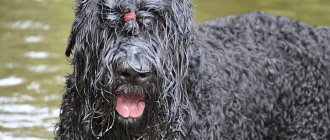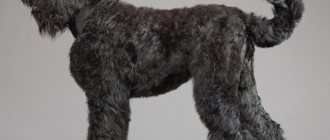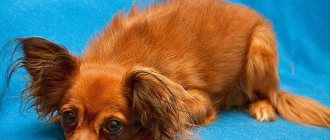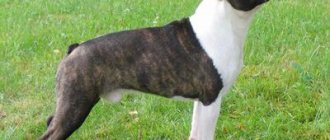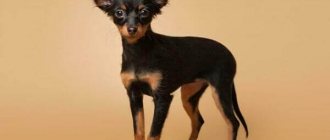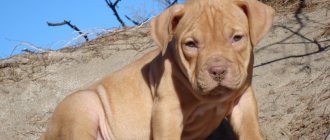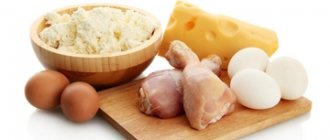The Toy Terrier, like all small breed dogs, often suffers from dental problems . Sometimes their loss begins already in the third year of life. Therefore, the owner must carefully monitor the condition of the pet’s oral cavity. A particularly important point is the change of teeth in a puppy.
If the dog is weakened and often sick, the process may take longer and go wrong. It is necessary to monitor the animal’s nutrition from early childhood , enrich the diet with vitamins and calcium, and also provide it with protection from hypothermia. Read more about the correct maintenance of a toy terrier here.
Change of teeth in a toy terrier
At the time of birth, Toy Terrier puppies are completely toothless .
They begin to appear only after two weeks. After two months , a properly developing pet should have 28 milk teeth . Sometimes this number may be a little more or less, there's nothing wrong with that. Over time, they will fall out anyway, and permanent ones will grow in their place.
When teeth change
The teeth of a toy terrier are replaced 4-6 months after birth. The first step is to replace the incisors. Permanent roots begin to form under their roots, they displace the milky ones and they fall out.
After this, the edges change and, lastly, the fangs change.
Important! If the dog participates in exhibitions, then by the age of 8 months all its milk teeth must be removed so that the permanent teeth can form with the correct bite.
For those pets that are not show animals, the shift can last up to a year.
If a one-year-old dog still has baby teeth, they need to be removed immediately .
To do this, you should contact a specialized clinic, where a veterinarian will really assess their condition and remove them either under local anesthesia or under general anesthesia.
The first method is well suited for animals whose teeth are quite loose. If they are still firmly seated, then anesthesia is used, since sometimes, even after local anesthesia, some dogs feel pain, which puts them under great stress and makes the removal difficult.
Small and fearless Russian Toy Terrier – Russian Toy Terrier
The Russian Toy Terrier is a decorative, “lap” dog, extremely loyal and affectionate. The size and weight do not exceed the dimensions of a cat: height 20-26 cm, body weight - 1.3-2.7 kg. Life expectancy is quite high - up to 15 years. Nowadays, it occupies a strong leading position among breeders among Yorkshire terriers and Chihuahuas.
Appearance
The Russian Toy Terrier is an elegant dog with long straight legs and lean muscles. His neck is elongated and elegant. The tip of the nose, depending on the color of the toy, is brown or black. The ears of such dogs are erect, thin, set high and have the shape of an isosceles triangle with pointed or rounded tips.
Among Russian Toy Terriers there are two variations: smooth-haired and long-haired. The first have: the coat is shiny and short, close to the body, there is no undercoat or bald patches; in the second, the coat is moderately long (3–5 cm), can be somewhat wavy or straight, frames the body without hiding its contours.
The color is usually uneven: on the face, chest and limbs there are spots lighter than the main tone. The color of the coat, as well as its shades, is variable: from fawn to black. The color is rich.
Gender is weakly expressed outwardly, however, it is clearly manifested in the behavioral line.
Character
Dogs of this breed are surprisingly dynamic and playful. They are friendly and get along well with others, including other pets. They are especially loving towards their owners and are also extremely loyal to them.
The psyche of Russian toy terriers is labile - they are very emotional dogs that “take everything to heart.” There is a danger of stress. In this regard, the animal should not be scolded, left alone, and it is advisable to exclude loud sounds that may frighten it.
Toy terriers are excellent for home keeping. For kids, the dog will be an ideal play companion; will give elderly and lonely people all the overwhelming affection and warmth, brightening up the gray days.
Caring for the Russian Toy
Dogs of this breed are unpretentious in maintenance. These are not the big dogs that need to be walked several times a day. The toy is great at learning to go to a regular cat litter box when needed. However, walking cannot be completely ruled out. A small terrier needs periodic outings into nature and fresh air for its psychophysical health.
This dog does not require frequent bathing, only once a month. During water procedures, it is worth inserting cotton wool into your ears to prevent water from flowing into them. In addition, your ears should be checked for infections from time to time. Also, as necessary, the toy's claws are trimmed.
Caring for the coat of the long-haired variety comes down to daily combing with a fine-toothed comb - a pleasant procedure for both the pet and its owner. Although a terrier is considered a tame dog, you shouldn’t carry it in your arms or in a bag all the time, it needs a burst of bursting energy.
Feeding
Despite the fact that the Russian Toy Terrier is a miniature dog and does not need large portions of food, its diet must still contain all the necessary nutrients and minerals.
Adult dogs
Feeding rules:
- main meals: twice a day - in the morning and after an evening walk;
- It is allowed to pamper your pet with a treat in the middle of the day (dog biscuit, leather bone);
- calculation of the daily diet: 50–80 grams of food per 1 kg of animal weight;
- when calculating daily feeding, the dog’s lifestyle is taken into account: older and inactive people require less food than young and active people or pregnant women;
- food should be at room temperature;
- The water is certainly raw, but filtered.
Daily diet:
- meat: lamb, veal, raw beef;
- poultry: boiled turkey and chicken (boneless);
- sea fish - boiled fillet;
- porridge: oatmeal, buckwheat, rice (with water);
- fermented milk products: low-fat cottage cheese, kefir, fermented baked milk;
- vegetables (carrots are required) - fresh (grated on a fine grater), stewed, boiled (without salt);
- fruits: bananas and apples are especially useful.
Weekly (no more than once):
Boiled eggs;
- offal: heart, kidneys, liver;
- corn porridge.
Contraindicated products:
- milk;
- sausage (any);
- smoked products;
- pork;
- nuts;
- legumes;
- sweets;
- bell pepper
If you prefer to feed your pet dry food, you will find the necessary instructions for this on the package. There is no universal guide for dry food, since different manufacturers have different compositions of nutrients included in them.
High-end ready-made food is produced by: Hills, Royal Canin, Orijen, Canidae, Eagle Pack. Please note that these companies produce food specifically for small dogs, some even by breed, as indicated on the packaging.
Puppies
Naturally, from the moment they are born, babies are fed exclusively with mother's milk. After three weeks, without removing the mother from the breast, small complementary foods are introduced. Additional food in the form of beef and low-fat cottage cheese is given in small peas - always warmed to room temperature - 3 times a day.
Menu from 6 to 8 weeks (feeding every 4 hours):
- 1 feeding: a ball of raw meat;
- 2 feeding: cottage cheese diluted with milk or kefir;
- 3 feeding: cottage cheese again;
- 4 feeding: porridge boiled in water - rice, oatmeal or buckwheat;
- 5 feeding: milk porridge;
- 6 feeding: a pea of raw meat.
It is best for puppies to eat meat from the menu listed above, however, you should not exceed the recommended daily portion. There is a significant risk that she will continue to prefer only meat. Ignoring other foods will have a bad effect on his health and overall well-being.
The diet from two to five months remains the same, supplemented with vegetables and fruits. Meals are reduced to four times a day.
From five months, the feeding schedule is adjusted to three meals a day, and after nine months - to two meals a day, with the transition to the diet of adults.
It is extremely important to ensure that the baby receives the food it needs in full. Otherwise, this is fraught with improper development of the musculoskeletal system.
This can be tracked quite simply: the puppy must be periodically felt - the ribs should not be noticeable, but they should be felt.
If you deviate from this condition, you need to adjust the power supply, depending on which direction the slope goes.
Upbringing
Despite their diminutive size, they are still terriers, and they have a rather serious character with a bright temperament.
Toys are perfectly trainable and if aggression is noticed in a puppy, it should be sent for re-education. This will help avoid problems with aggression in the future.
However, “characteristic” toys are a rarity; most of them are cute and cheerful dogs.
It is important to remember that a “lap” dog is not a cat that walks on its own, nor is it a toy. She has her own needs, characteristics and instincts.
If this is neglected, then the risk of developing “small dog syndrome” or “Napoleon complex” increases in the toy terrier.
At the same time, the dog will become uncontrollable: he will consider himself the main one in the house, bark at everything that does not suit him, and rush at others.
To avoid excessive self-will, you must strictly follow a number of rules:
- do not allow him to aggressively jump on people;
- do not allow barking and growling whenever you want;
- make sure that the dog does not climb onto your lap on its own;
- prohibit sleeping on the owner's pillow.
Changing baby teeth
The Russian Toy Terrier, despite its miniature size, has the same set of teeth as the Caucasian Shepherd Dog - 42 pieces. Of these, 22 are located on the lower jaw and 20 on the upper jaw. They include 4 types of teeth: incisors, canines, molars and premolars.
Although it is important for toy terriers intended for exhibitions to have all their teeth, they are not disqualified due to the absence of molars. In addition, such dogs are allowed for mating.
Toys are born with absolutely no teeth. The first primary canines erupt on days 12–16 of life. Then, on each jaw another 6 premolars and 6 incisors are shown. The number of primary premolars is exactly this due to the fact that at this age the first tooth is still missing. By two months, approximately 28 baby teeth have formed in the toy's mouth.
The replacement of baby teeth with molars begins at the age of four months or six months and continues until eight months. The incisors are replaced first. Under the roots of the deciduous teeth, the rudiments of the molar incisors are born, during which the roots of the first ones dissolve and become shaky. Then the baby teeth fall out on their own.
In show Russian Toy Terriers, by the age of eight months, absolutely all their teeth should have changed. If this does not happen, you should be wary. Due to the fact that the molars grow along the same canals as the milk teeth, failure of the latter to fall out may result in a lack of growth or curvature of the former.
During the period when puppies are changing their teeth, you need to carefully monitor their health. In weakened dogs, this process may be delayed or extended over time. Make sure you have enough vitamins and protection from hypothermia.
If a baby tooth does not fall out on time, you can try to help the baby on your own. To do this, gently shake the tooth that is about to fall out. The degree of unsteadiness will increase and eventually it will fall out. If you can’t cope on your own, you need to take the puppy to a veterinary clinic. There he will be helped in this matter with the use of anesthesia or anesthesia.
Health
With high-quality maintenance of Russian Toys, they practically do not get sick.
It is important to ensure that the dog does not fall. In particular, you should not take risks by lifting it onto objects whose surface is higher than 40 cm from the floor.
It is also necessary to control the toy's contacts with large dogs. In both cases, the injury may be caused by the inability of terrier dogs to balance their size and strength with their desires.
These dogs simply do not feel their small size (especially cables).
When a dog comes into contact with a very small child, it is necessary to closely monitor their games. A baby who does not yet know how to coordinate his movements and control strength can accidentally cause serious injury to the dog.
Do not buy a Russian Toy Terrier puppy on the market, there is a high probability that the dog will be nervous and sickly. To be absolutely sure of your dog’s psychophysical health, contact only trusted breeders.
Organs most susceptible to diseases:
- teeth;
- skeletal system;
- skin covering;
- pancreas;
- heart muscle.
: presentation of the Russian Toy Terrier breed
Source: https://toy-teryer.ru/malenkiy-i-besstrashnyy-russkiy-toy-terer/
How to clean
To keep your dog's mouth healthy, you need to brush both his baby and permanent teeth . Before this, you need to remove plaque and stone, if any, with hydrogen peroxide.
After this, you need to brush your pet’s teeth with a special brush and paste.
On a note! Brushing your teeth will be difficult at first. But, over time, the dog will get used to the procedure.
What dental diseases are common in dogs?
Bad breath
Causes
If you feel that your dog's breath has become foul, do not think that the problem is only in the diet. Most likely, the number of bacteria in the oral cavity increases. They transform into plaque, which leads to inflammation and bleeding of the gums. Teeth also suffer, resulting in the formation of stones and caries.
Bad breath can signal plaque, which can lead to sore and bleeding gums.
Symptoms
- unpleasant odor from the mouth;
- pain when eating;
- dark enamel color.
Treatment
Ultrasonic cleaning in the veterinarian's office. Oral care at home. Diagnosis of gastrointestinal diseases.
Tartar
Causes
The most common problem occurs in dogs that eat mostly dry food.
Symptoms
Can be seen on the side of the jaw box. It usually accumulates near the teeth that are adjacent to the cheeks. When the gums and teeth come into contact, severe bleeding begins and pain occurs. The stone appears in both large and small breeds of dogs.
Tartar in a dog
Treatment
Large dogs are given a sedative injection. After the animal becomes limp, its mouth is opened and plaque is scraped off and stones are removed from the affected areas. The doctor’s task is to localize the site of tissue destruction. Cleaning can be done using hand tools or high pressure water. The last option is the most attractive, since not only all dirt is cleaned out, but the entire oral cavity is washed. The risk of re-infection is minimal. If necessary, the doctor takes samples of dental tissue to determine the cause of stone formation or the causative agent of infection.
Today, there are several ways to clean your teeth. The doctor chooses a method depending on the individual characteristics of the animal. The owner separately decides on the need to use anesthesia. The most commonly used measures are mechanical and professional cleaning. Professionally performed using ultrasonic equipment.
Before and after dental tartar removal in dogs
Caries
Causes
Becomes a consequence of consuming unhealthy foods.
Symptoms
Appears as a brown coating. Appears mainly on the back teeth. Causes itching and discomfort.
Treatment
When a veterinarian diagnoses the destruction of dental tissue due to the development of caries, it is recommended to remove the affected tooth completely in order to prevent the development of caries on other teeth. It is not advisable for dogs to have fillings.
Caries in dogs
Unfortunately, dogs have a very thin layer of enamel; the tooth structure itself is very fragile. Any repair can result in complete destruction. In addition, the dog will be put under anesthesia, which will not have the best effect on the animal’s health.
Tooth extraction in small breed dogs occurs without anesthesia, in large breed dogs - only under it. If the gums diverge, surgery is possible to restore the integrity of the tissue.
Tooth decay
Causes
Occurs as a result of a lack of nutrients and vitamins in the body. The lack of calcium affects. The teeth begin to crumble and decay. Pointed teeth can injure the tissues of the gums and cheeks, and bacteria can enter there.
What to do if teeth fall out
In a Toy Terrier, loosening and loss of permanent teeth can begin very early .
Therefore, for prevention purposes, it is necessary to enrich the puppy’s diet with solid foods from an early age: carrots, beets, apples and others. A good load from chewing them will strengthen the jaws. The main reasons for loss include:
- Plaque that, if not regularly removed, causes inflammation of the gums;
- Tartar that destroys enamel;
- Gingivitis, a disease that begins with inflammation of the gums, and without proper treatment ends with their atrophy;
- Periodontitis, accompanied by bleeding and decay of the gums.
Important! If any of these causes are detected, you should immediately contact your veterinarian.
He will conduct an examination, take an x-ray if necessary and prescribe appropriate treatment.
In addition to oral debridement and drug treatment for gingivitis or periodontitis, small breed dogs often undergo splinting , which eliminates looseness. With this procedure, teeth are fixed and inflammatory processes are stopped.
If your terrier has problems with his teeth, then you need to urgently treat them. The fact is that problems with the oral cavity negatively affect the general health of the dog, causing various diseases. Veterinarians say that a dog’s life expectancy directly depends on the condition of its teeth.
Replacing baby teeth with permanent teeth
The change of teeth in a dog starts as soon as the first milk teeth firmly take their places, i.e. approximately from the end of 3 months. It is impossible to say exactly how many months the change occurs - usually we are talking about the full first year of life. Those. milk teeth are completely replaced by permanent ones by the end of the first year of life or up to 9 months in large and medium-sized dogs and 10-11 months in small ones. At one year of age, a dog of any breed should already have permanent, strong, white and sharp teeth.
Formula for permanent (molar) bite in dogs
12 incisors (6 pieces on top and bottom);- 4 sharp, slightly curved canines (2 on each jaw, immediately behind the incisors);
- 16 premolars (8 pieces on each jaw or 4 pieces on each side above and below);
- 10 molars (top 4 - 2 on each side, bottom 6 - 3 on each side).
In the primary dentition there are no molars or extreme premolars. The difference between a baby set of teeth and a permanent set is 10 or 14, depending on the breed.
Scheme of replacement of primary teeth with permanent teeth
The change does not occur in the order in which the dairy plants began their growth:
- first the incisor hooks fall out, then the middle ones and the edges (from the 4th to the end of the 5th month);
- the first molars grow immediately behind the premolars, which did not have a “milk” base - they do not allow the dentition to shift at the time of replacement of false molars;
- are replaced by permanent premolars (6-8 months);
- the change of fangs ends at 6-7 months - simultaneously or after the premolars;
- All other (new) molars grow in (7-9 months).
Bottom line: when (at what age) do dogs change their teeth? Between 3-4 and 10 months.
In large breeds and simply large dogs, the change occurs somewhat faster than in small, decorative dogs (but up to 1 year). This is explained by the fact that in small breeds the teeth often do not have time to fall out before the molars begin to grow underneath them. That is why small dogs need to have their mouths regularly examined to prevent deviations in the change of teeth during the first year of life.
Why do you need to know how many months a dog’s teeth change? This process significantly affects the state of the animal’s immune system. During this period, no vaccinations are carried out, and veterinarians strictly announce the time for repeated vaccinations - after changing teeth!
General characteristics of a healthy grin
By the end of the first year of life, the dog has formed a healthy, strong, permanent grin of 42 teeth. Any deviation in quantity, both up and down, indicates disturbances in the intrauterine development of puppies or mutations at the genetic level. After changing during life, the color changes from white to slightly yellowish (baby teeth in dogs have a pearly white tint).
The angle of growth of the teeth and the contact of the upper and lower jaws (bite) varies somewhat among different breeds of dogs. Deviation from the normal location has its own name.
With age, older dogs experience wear of dental crowns and grinding of fangs. With proper bite, wear occurs evenly and does not affect the quality of life of even elderly dogs.
Different types of bites in dogs
undershot;- pincer-shaped (or straight);
- scissor-shaped (or normal);
- bulldog-shaped;
- snack.
How often does a dog's teeth change throughout its life?
A dog's teeth must be replaced once during his entire life and only in the milk series. Indigenous ones grow once and cannot be replaced. Any loss of a permanent tooth in a dog over 1 year of age clearly indicates some kind of health problem.
Treatment at home
The doctor will not trust the owner to perform any manipulations with the teeth at home. But it is within the power of the animal owner to take measures that will enhance the effect of treatment in a veterinary clinic.
During treatment it is necessary to feed the animal with natural food.
For some reason, owners of various breeds believe that dry food prevents the development of diseases. Actually this is not true. After eating dry granules, teeth become clogged, and brushing has to be done much more often. If the animal’s diet contains a lot of natural bones, meat, and vegetables, then such a diet will maintain the cavity in proper order. It remains to avoid injury to the gums by bones.
Not all animals are amenable to oral cleaning. If you find it problematic to brush your teeth several times a week, raw bones will come to the rescue. If the animal eats only dry food, purchase special bones for cleaning teeth at veterinary stores.
Teeth cleaning bones for the prevention of dental diseases in dogs
It is necessary to regularly inspect the animal's mouth: plaque forms on average in 10-20 days, so a regular inspection of the jaw once a month is not only good prevention, but also monitors the healing process.


